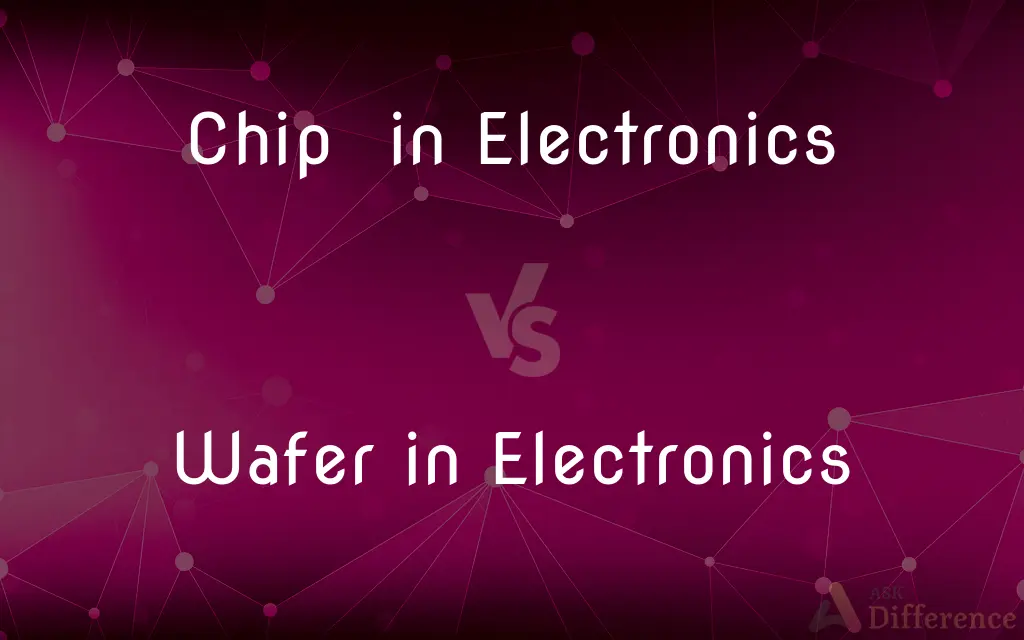Chip in Electronics vs. Wafer in Electronics — What's the Difference?
Edited by Tayyaba Rehman — By Fiza Rafique — Published on December 1, 2023
In electronics, a chip is a small piece containing integrated circuits, while a wafer is a thin slice of semiconductor material from which multiple chips are made.

Difference Between Chip in Electronics and Wafer in Electronics
Table of Contents
ADVERTISEMENT
Key Differences
In the realm of electronics, a chip is essentially the heart of electronic devices, containing a series of integrated circuits. On the other hand, a wafer serves as the foundational material, typically made of silicon, from which these chips are extracted.
The manufacturing process of chips involves using wafers as a starting point. Several chips are etched onto a single wafer, and once the process is complete, these chips are separated. In contrast, the wafer is processed to have the desired electrical properties before any chips are etched onto it.
When visualizing a chip in electronics, think of it as the final product, a tiny piece designed to execute specific electronic functions in devices. The wafer, however, represents the raw material, a larger disc, from which multiple chips will eventually be produced.
The significance of a chip in electronics lies in its ability to process and store information, making our gadgets smart and functional. Wafers in electronics play a foundational role, ensuring that there's a base material to manufacture the essential chips.
While chips are the end products integrated into our electronic devices, wafers are intermediary products in the manufacturing process. A single wafer can yield hundreds or even thousands of chips, depending on its size and the design of the chips.
ADVERTISEMENT
Comparison Chart
Definition
A small piece with integrated circuits.
A thin slice of semiconductor material.
Role
Executes specific electronic functions.
Base material for chip manufacturing.
Position in Manufacturing Process
End product.
Intermediary product.
Size
Much smaller than wafers.
Larger discs from which chips are extracted.
Quantity from One
One chip is a single unit.
One wafer can yield hundreds or thousands of chips.
Compare with Definitions
Chip in Electronics
Represents the brain of most digital devices.
The laptop's chip in electronics processes data rapidly.
Wafer in Electronics
The starting material for chip manufacturing.
Hundreds of chips are etched onto a single wafer in electronics.
Chip in Electronics
Responsible for computation and data storage.
The memory capacity of the chip in electronics has increased over the years.
Wafer in Electronics
Can yield multiple chips once processed.
Advances in technology allow more chips to be made from a single wafer in electronics.
Chip in Electronics
An assembly of transistors and resistors on a single piece.
This chip in electronics has over a billion transistors.
Wafer in Electronics
Typically made from silicon or other semiconductors.
The purity of the silicon in the wafer in electronics is crucial for performance.
Chip in Electronics
A piece that contains integrated circuits.
The performance of the device is determined by the chip in electronics.
Wafer in Electronics
Processed to achieve desired electrical properties.
The wafer in electronics undergoes doping to modify its characteristics.
Chip in Electronics
The functional unit in electronic devices.
The chip in electronics made the smartphone exceptionally fast.
Wafer in Electronics
A thin slice of semiconductor material.
The wafer in electronics serves as the foundation for chip production.
Common Curiosities
Can a single wafer produce multiple chips?
Yes, a single wafer in electronics can yield hundreds or even thousands of chips, depending on size and design.
How are chips separated from wafers?
Chips are separated from the wafer using a process called dicing or sawing after the manufacturing process is complete.
Are all chips in electronics made of silicon?
While many chips in electronics are silicon-based, chips can be made from other semiconductor materials too.
How small can a chip in electronics be?
With advancements in technology, chips in electronics can be incredibly tiny, some even smaller than a grain of rice.
Is silicon the only material used for wafers?
While silicon is the most common material for wafers in electronics, other semiconductors like gallium arsenide can also be used.
Why is the chip in electronics essential for gadgets?
The chip in electronics processes information, making electronic devices functional and smart.
What is a chip in electronics?
A chip in electronics is a small piece containing integrated circuits used in electronic devices.
What happens if there's a defect in the wafer in electronics?
Defects in the wafer can result in faulty chips, which is why quality control is essential in wafer production.
What role does a wafer play in electronics?
A wafer in electronics is a thin slice of semiconductor material from which multiple chips are made.
Why are wafers thin and disc-shaped?
The disc shape of wafers in electronics ensures uniformity in processing, and thinness is essential for efficient chip extraction.
Share Your Discovery

Previous Comparison
Action Verbs vs. Linking Verbs
Next Comparison
Epithelial Tissue vs. Connective TissueAuthor Spotlight
Written by
Fiza RafiqueFiza Rafique is a skilled content writer at AskDifference.com, where she meticulously refines and enhances written pieces. Drawing from her vast editorial expertise, Fiza ensures clarity, accuracy, and precision in every article. Passionate about language, she continually seeks to elevate the quality of content for readers worldwide.
Edited by
Tayyaba RehmanTayyaba Rehman is a distinguished writer, currently serving as a primary contributor to askdifference.com. As a researcher in semantics and etymology, Tayyaba's passion for the complexity of languages and their distinctions has found a perfect home on the platform. Tayyaba delves into the intricacies of language, distinguishing between commonly confused words and phrases, thereby providing clarity for readers worldwide.
















































